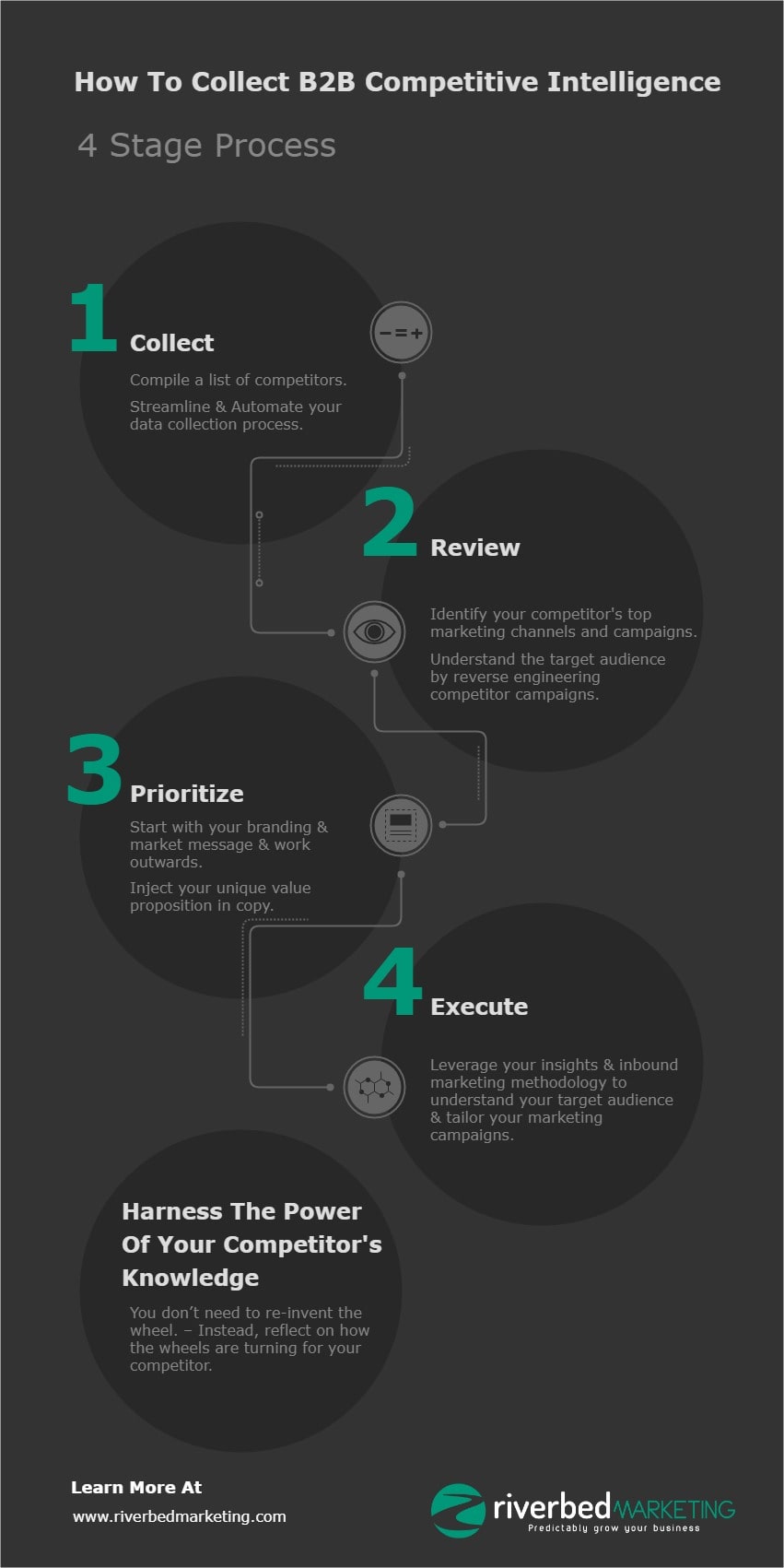As the digital marketing landscape becomes increasingly saturated with competitors over time, B2B marketers need to think fast and stay agile with their marketing budgets.
Not all B2B lead generation campaigns you conduct will be successful… In fact,
“Only 18% of marketers say outbound practices provide the highest quality leads for sales.” (Hubspot)
You could either not be doing enough of what you are currently doing -OR- You may need to revisit what is working better for your competitors.
With these considerations in mind, the cunning B2B marketer will remember the principles Occam’s Razor when they look at how to overcome their best-in-class competitors.
“Suppose there exist two explanations for an occurrence. In this case, the one that requires the least speculation is usually correct.”
When it comes to prioritizing the most effective campaigns for your lead generation efforts, you don’t need to reinvent the wheel. – Instead, reflect on how the wheels are turning for your competitor. Herein lies the power of B2B Competitive Intelligence for marketing.

Table of Contents
ToggleWhat is B2B Competitive Intelligence?
B2B Competitive intelligence is the process of researching and collecting intelligence information about your competitors and leveraging it for marketing purposes. This process can take a lifetime to master but offers many rewards insofar as maximizing your marketing budget. Understanding the success of your top competitor allows you to accelerate your marketing efforts past the experimental stages and progress to refining your campaigns into strong lead generation pipelines.
What is the Importance of Competitive Intelligence?
Marketing costs time and money which can become cumbersome when it’s not producing positive ROI for rising brands in the B2B space. With properly conducted B2B competitive intelligence, you can review your competitor’s top marketing channels and identify what assets and resources are working for them. The end result ties all these concepts together so you can tailor your own marketing campaigns and learn from their successes and mistakes.
So, let’s get started with the process!
Determine Your Criteria & Goals
Start out by identifying some goals your research aims to achieve. You may be experiencing poor performance in your email channels, or are finding the leads are not a good match to the message you are providing during your sales cycle.
Critiquing yourself can be hard to do, but look at your own efforts objectively and be critical about where you are not successful. The research material you acquire should be aligned to help support your primary marketing goals and ultimately help you get to a stronger end result, faster.
- Identify top performing campaigns of your competitors
- Identify key marketing channels for our industry
- Identify content mediums that are engaging our target audience
- Identify a common narrative and mutual language that resonates with your target audience within your competitor’s marketing assets
- Validate market research & other industry knowledge through active investigation of competitor campaigns
Next, you want to focus on your competitive analysis criteria to acquire the insights you need to meet your goal. The best starting point is envisioning yourself head to head with your competitor on a traditional product comparison table. Identify your shortcomings, and where you accelerate as best-in-class. – Take time to really explore the details applicable to your industry as it relates to marketing.

B2B Competitive Intelligence Criteria Checklist
General Competitor Intelligence:
- Company Name & Website URL
- Location Information
- Directly competing for the same products or services
- Partially competing for the same products or services
- Distribution Channels
- Services or goods
- Shipping
- Digital Formats
- Pricing
Marketing Competitor Intelligence:
- Active Digital Marketing Channels
- Search Engine
- Paid Advertising
- Email Marketing
- Social Media
- Presentation Media & Webinars
- Video Marketing
- Active Offline Marketing Channels
- Hosted Events
- Sponsorships & Partnerships
- Related industry workshops & events
- Marketing Assets & Martech Stack
- Brand content, messaging & tone
- Unique Value Proposition
- eBooks & guides
- Gated content
- Primary/Secondary/Tertiary offers – Do their marketing funnels take you deeper into additional offers?
- Newsletter Subscription – what are they incentivizing?
- Case Studies & Testimonials
- Additional Initiatives
- Strategic Partners
- Competitor Job postings
- Interview your front-line sales team
This is not a definitive list. There may be other criteria appropriate to your industry that can be included. In a moment we’ll dive into the particular criteria for the review process.
This process helps you establish WHERE your competitors are active. Through this practice, you can move forward and find out WHAT they are doing.
Build a Structured Process
At the heart of every good lead generation campaign lies a structured process. When doing competitive analysis, it is easy to get lost in the proverbial rabbit hole if you don’t have a system to get to the end result you want.
Start by building a competitor list using a streamlined & automated system to collect your General Competitor Intelligence information.
You can use prospecting tools such as FindThatLead, Seamless.ai, clutch.co and a variety of other prospecting tools to streamline the basic information collection process. This can save huge amounts of time by leveraging technology to collect all the preliminary details so you can focus on the deeper review by-hand.
With these foundations in place, you can structure a 4-pronged strategy of; Collect, Review, Prioritize, Execute.

At last, you’re ready for the manual review. Let’s dive into the review process and (more importantly) the thought-process behind what information you are investigating, starting with the data collection.
COLLECT
Prospect Your Competitors
Using tools, prospect the desired industry and compile a list of relevant companies.
- This will include contact info, some relevant social profiles, and other information to get started.
- When doing your review, be sure to prioritize the competitors you are aware of as well as common competitors in Google, etc.
Identify Directly Competing Vs. Partially Competing competitors
Both types of competitors are worth reviewing, but subtle differences may not always apply to your own marketing. It’s important to understand the nuances to avoid strategies that may not work well.
- Do direct competitors have common strategies they are using such as email marketing, paid advertising, and content marketing?
- Are there other strategies from other competitors or industry leaders where you can glean some inspiration from?
Distribution Channels
Identify and make a note of their distribution channels. With an understanding of this information, you can then identify marketing channels that you may have otherwise missed.
- Goods or Services? – is there shipping? If so, to where?
- Service locations – established organizations will root themselves in hotspot markets they’ve advanced into. Look to these areas as insights into established markets in your industry.
- Digital distribution – Who are their distributors if applicable? What are the marketing channels they operate in?
Competitor Pricing
Review how the pricing is structured and how it stacks up to your own pricing. A lot can be understood from how your competitors have evolved their pricing model to meet the demands of your target audience.
- In many B2B industries, the price may not always be listed. In advanced cases, it can be appropriate to deploy the use of a secret shopper to go through your top competitor’s sales funnel. This can be a tricky process and is always best handled by a non-bias third-party. – Established competitors have had many engagements with your target audience and know what works. Look to this knowledge as key identifiers of how you can structure your sales process.
REVIEW
At this stage, you will have established the foundations of where your competitors operate and built a list. Now it’s time to tie it all together and do a deep-dive of your competitor’s marketing assets and campaigns.
Active Digital Marketing Channels
Take account of the common marketing channels the competitor is active in such as Search engines, social media, and email.
- Search Engines – Run several searches for your industry and identify the top-ranking competitors in your space. This can help you strategize and effective B2B SEO strategy and proper keyword targeting. This can be crucial in high-competition markets and costly in Google Ads if research is not applied.
- Social Media – Start with their website and check to see which profiles are active. Is there a common trend amongst your aggregate list?
- Email – Is there a newsletter or downloadable offer incentivizing email collection?
- What does the email campaign look like on the other end?
- Paid Advertising – Are they running any PPC or social media campaigns? Use inspection tools such as SEMRUSH or Spyfu to test.
Active Offline Marketing Channels
Many B2B organizations rely on a blend of digital campaigns and offline marketing engagements such as events, conventions, and workshops. Take note of participating events by checking for a “News” section on their website and conduct a competitor search in Google to find traces of past events conducted.
- Industry Events
- Partnership Sponsorships
This information can be extremely powerful in uncovering new opportunities within your industry.
Brand Content, Messaging, Tone & Unique Value Proposition
Determine common language used when they are promoting products and services to your target audience. More evolved organizations will have gone through the rigorous process of testing website copy and the delivery. Take account of the knowledge gained and adapt your campaigns accordingly.
- It’s important to see how your competitors inject their unique value proposition into the marketing content they deploy for their brand. You don’t want to replicate the content but replicate the approach. – Use common language and inject your unique value proposition accordingly. Hook their attention with familiar language, and reel them in with what makes your brand exceptional.
Marketing Assets & Martech Stack
What you say is just as important as how it is said. Take some time to review your competitor’s marketing message as well as the mediums they are deploying for their content marketing efforts.
- Are they producing a lot of downloadable or gated content? – if so, what do their email marketing sequences look like?
- Are there hosted webinars, trials, or demos?
- Are they leveraging interactive content or other formats?
- Are there any Case Studies or Testimonials being positioned as lead nurturing assets?
- Check for the use of B2B Marketing Automation solutions being deployed to help you better understand how competitors are managing the leads. You can use Wappalyzer for detailed insights into the CRM and CMS your competitors are using.
- Reverse engineering the success will help you identify target audience challenges that can be solved with your own marketing message & technology solutions.
Strategic Partnerships
Some industries rely on strategic partnerships for operations or distribution channels within their organization. Check for brand logos and other footprints on their website and LinkedIn profiles.
- Whether you can act on the information or not, you’ll always turn up with a deeper insight into what makes the industry tick.
Job Postings
You can discover many interesting details from what your competitors are doing within their hiring programs. Investigate their careers page and third-party job posting boards. – You can often uncover ways your competitor is growing and discover focus points they are pursuing to grow their organization. This can be a powerful insight when applied towards forecasting the needs of your own organization.
PRIORITIZE
As you can see by the depth in this process, it’s an ongoing effort. Question your assumptions and take time to interview your own sales team to validate your findings. The insights you can acquire from the front-end sales team help strengthen the bond between marketing and sales. This translates to a consistent and compelling experience for your target audience from marketing to sales.
Spend time analyzing where your competitors are stepping up their game or adapting to change in the industry on your findings from the review process. Focusing on these areas will provide good detail into where you can invest more resources.
Applying these insights to your own marketing can seem daunting at first, but you can work through a simple process to get started. Start with your website and brand message. If you’re not saying the right thing, any promotional efforts you make beyond that is time wasted.
EXECUTE
Deploying the right changes starts by leveraging B2B Inbound Marketing Methodology and best practices. Understanding your target audience & having a message that speaks to their challenges and needs is single-handedly the most important foundation that the competitive intelligence process serves to uncover.
From there, you can take account of your competitor’s top marketing assets and marketing channels to craft a strong campaign based on the best-practices actively working in your industry.
—
Remember, B2B competitive intelligence takes time and patience to properly master. This is true because it commands that you properly assess the unique needs of your prospects, identify opportunities your competitors are exploiting, and then prioritize the highest impact marketing initiatives to accelerate lead generation.
Take the time to understand and replicate the strategies that are working. Apply your own brand messaging and unique value proposition to make it your own.
Harness the power of your competitor’s knowledge with this competitive intelligence research process today! – Reach out to Riverbed Marketing for a free B2B marketing assessment that will help you effectively strategize your next B2B marketing campaign.











